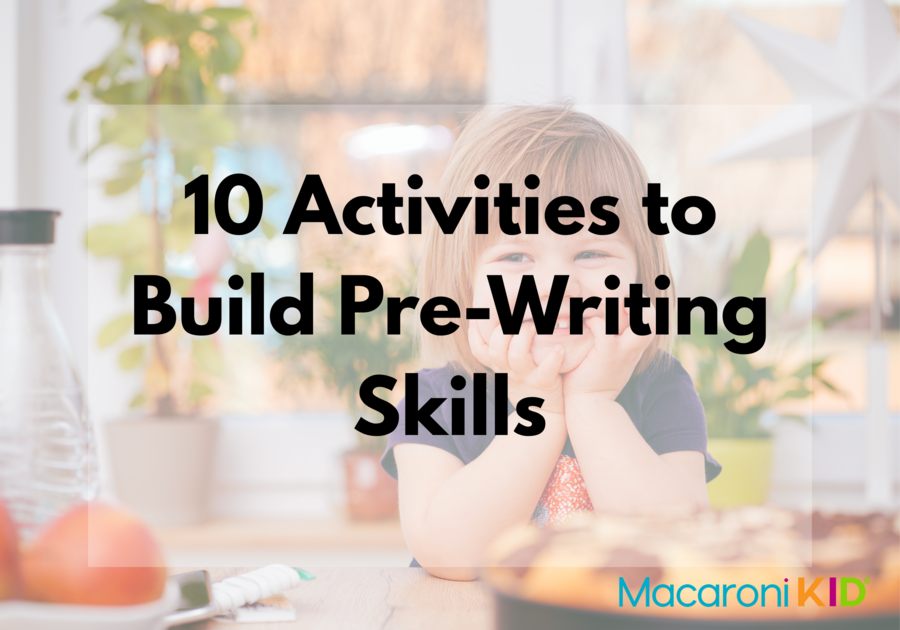In my role as a special education teacher, one worry I hear from parents of young children over and over is handwriting. Parents worry about their young chidren's hand writing, ability to build fine motor and hand strength more than I hear them worry about learning to read. If you want to get the most bang for your buck with these activities, you can work on letter sounds with the writing.
Helping to build these skills can be done at home but my suggestions is that they are made fun and no pressure. These activities are ones that children can work on independently and offer parents a chance to praise the effort not the final product.
Tracing Letters and Shapes (Fine Motor Skills)
Why it’s great: Tracing is a wonderful way for young children to practice letter formation and improve their pen control. The repetitive motion helps them develop muscle memory for writing.
How to do it:
- Print or draw large letters and shapes on a piece of paper and encourage your child to trace over them with a pencil, crayon, or marker.
- You can start with basic shapes (circles, squares, triangles) before moving on to letters and numbers. For a more fun twist, try tracing with colorful markers or using textured paper (like sandpaper) to engage more senses.
- To further challenge your child, make a set of flashcards with letters and numbers for them to trace repeatedly.
Bonus Tip: Use a highlighter to write the letters first, then ask your child to trace over them with a pencil. This provides a clear visual guide while still allowing for handwriting practice.
Sand or Salt Tray Writing (Tactile Learning)
Why it’s great: Writing in a sand or salt tray offers a tactile, sensory-rich experience that helps children practice letter formation and develop fine motor skills.
How to do it:
- Fill a shallow tray with sand, salt, or even rice. Show your child how to use their finger to trace letters and shapes in the sand or salt.
- For a more structured practice, you can write a letter on a card and have your child trace it in the tray. The texture of the sand encourages focus and helps children "feel" the shape of each letter as they trace it.
- This is a great activity for younger children who haven’t yet mastered using a pencil or pen but are ready to work on forming letters.
Bonus Tip: Make the activity more engaging by creating a theme—like tracing letters in "golden sand" or using colored salt—to captivate their attention!
Letter and Shape Stamps (Fine Motor Control)
Why it’s great: Using letter or shape stamps helps children practice letter formation while improving their hand strength and dexterity. It’s an enjoyable way to introduce handwriting in a low-pressure environment.
How to do it:
- Purchase a set of letter stamps or make your own with foam letters. Have your child stamp letters on a piece of paper, focusing on lining up the letters and forming words.
- After stamping, you can ask your child to trace the letters with a pencil to reinforce the correct formation.
- Another fun variation is to create a word or name by stamping the letters, then have your child copy the letters with a pencil underneath.
Bonus Tip: Use colorful ink pads to make the activity even more fun, and incorporate simple spelling games, like making a name or favorite word with the stamps.
Playdough Letters (Strengthening Hand Muscles)
Why it’s great: Manipulating playdough to form letters helps children develop hand strength and dexterity, which are crucial for improving handwriting. It also encourages them to visualize letter shapes in a 3D way.
How to do it:
- Roll playdough into long snakes and help your child shape the letters of the alphabet. This tactile approach encourages them to feel and form each letter with their hands.
- You can challenge your child by asking them to form a specific letter and trace it with their finger, or ask them to create an entire word.
- For more advanced practice, encourage your child to form uppercase and lowercase letters and then transition into numbers or simple words.
Bonus Tip: After making a letter, ask your child to “write” it in the air with their finger or use a finger to trace the playdough letter for sensory reinforcement.
Chalkboard or Whiteboard Writing (Repetition and Practice)
Why it’s great: Writing on a chalkboard or whiteboard offers a large space for children to practice their letters and numbers repeatedly. The easy-to-erase surface allows them to practice over and over again without wasting paper.
How to do it:
- Use a chalkboard or whiteboard to write letters, numbers, or simple words. Encourage your child to copy what you write or trace the letters with their finger before using a marker or chalk.
- Focus on letter formation, spacing, and size as your child writes each character.
- You can also use colored markers or chalk to make it more fun and visually engaging.
Bonus Tip: Make it a game by writing a letter and asking your child to identify it, or ask them to draw a picture and add a word to go with it.
Letter Hunts (Visual Recognition and Writing Practice)
Why it’s great: A letter hunt is a fun, interactive way to help children identify letters and practice writing them. This activity strengthens both their visual recognition and fine motor skills.
How to do it:
- Hide letter cards or magnetic letters around the house and have your child search for them. As they find each letter, ask them to write it down on a piece of paper or a whiteboard.
- To make it more challenging, have your child write a word or sentence using the letters they find.
- You can also incorporate other learning themes, like finding letters that spell out their name or favorite color.
Bonus Tip: Create a scavenger hunt where they must find objects that start with a specific letter, and then write the name of each object they find.
7. Tracing with Yarn or String (Motor Control and Precision)
Why it’s great: Tracing with yarn or string can be a creative way for children to develop hand-eye coordination and precision, which is essential for good handwriting.
How to do it:
- Lay a piece of yarn or string on a piece of paper in the shape of a letter or number. Ask your child to trace the shape of the letter or number with their finger, following the path of the yarn.
- For more advanced practice, you can ask your child to replicate the shapes using markers or crayons.
- The tactile sensation of following a string will help reinforce the movement of writing and improve their letter formation.
Bonus Tip: Use different colors of yarn or string to make the letters look visually appealing and encourage your child to focus on the patterns.
Dot-to-Dot Activities (Hand-Eye Coordination)
Why it’s great: Dot-to-dot activities help children practice both their number skills and handwriting by connecting dots in a sequence. This improves hand-eye coordination and provides a fun way to reinforce letter and number recognition.
How to do it:
- Use dot-to-dot worksheets that include letters, numbers, or pictures. Encourage your child to connect the dots in the correct order to form the letter or shape.
- After completing the dot-to-dot activity, ask your child to trace the letter or number and then try to write it on their own.
- You can find dot-to-dot sheets online or create your own with simple shapes and letters.
Bonus Tip: Add an element of creativity by asking your child to color in the picture once they’ve connected all the dots.
Writing on Fabric or Felt (Textured Writing)
Why it’s great: Writing on fabric or felt creates a different tactile experience that can help children focus on how their writing feels and improve their grip and control.
How to do it:
- Set up a felt board or lay a piece of fabric flat. You can use fabric markers, chalk, or crayons to write letters on the fabric. The texture of the material provides sensory feedback that helps children understand their hand movements better.
- You can also make a "letter board" where you place different textured items (like buttons, ribbons, or felt) that your child can trace with their fingers.
- For older children, this can be an interactive way to practice spelling out words and creating patterns with their handwriting.
Bonus Tip: Add a fun twist by making the letters or words in the fabric board “pop” with different colors or designs!
Create a Handwriting Journal (Ongoing Practice)
Why it’s great: A handwriting journal is an ongoing project that allows children to track their handwriting progress over time. By setting aside time each day for practice, children can improve their skills at their own pace.
How to do it:
- Provide your child with a notebook or journal where they can practice writing letters, numbers, and simple sentences.
- Set a goal for each practice session (e.g., practicing one letter or writing a short sentence), and review their progress regularly.
- Encourage creativity by letting your child draw pictures in their journal or decorate the pages with stickers or stamps.



